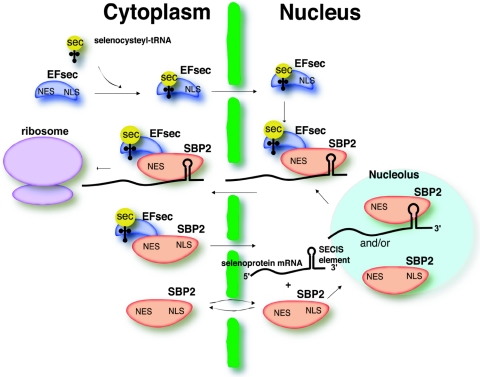FIG. 8.
Schematic model for localization and interaction of EFsec and SBP2. Selenocysteyl-tRNA (yellow) binds to the N-terminal portion of EFsec (blue) in the cytoplasm, and the complex of sec-tRNASec-EFsec is imported into the nucleus via the C-terminal NLS of EFsec. SBP2 (red) shuttles between the cytoplasm and nucleus via its NLSs and NESs. SBP2 binds to SECIS elements of selenoprotein mRNAs in the nucleus, either prior to or after shuttling in and out of the nucleolus. SBP2 binds the selenocysteyl-tRNA[Ser]Sec-EFsec complex in either the cytoplasm or nucleus. If this occurs in the cytoplasm, the NLSs of SBP2 are still exposed for import of the selenocysteyl-tRNA[Ser]Sec-EFsec-SBP2 complex into the nucleus and binding of selenoprotein mRNA. Alternatively, SBP2 may interact with selenocysteyl-tRNA[Ser]Sec-EFsec in the nucleus. Finally, either the mRNA export pathway or the NES of SBP2 would ultimately be responsible for the export of the complex into the cytoplasm for binding to ribosomes and translation of selenoproteins. This model would explain not only the localization data presented herein but also the observation that levels of SBP2 determine levels of selenoprotein expression.

